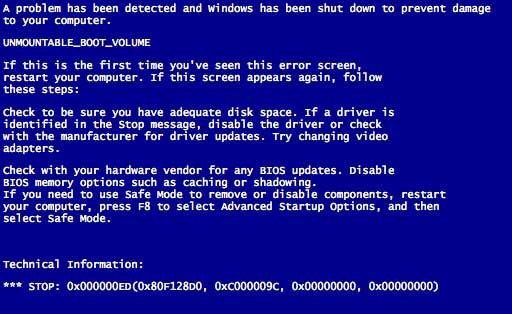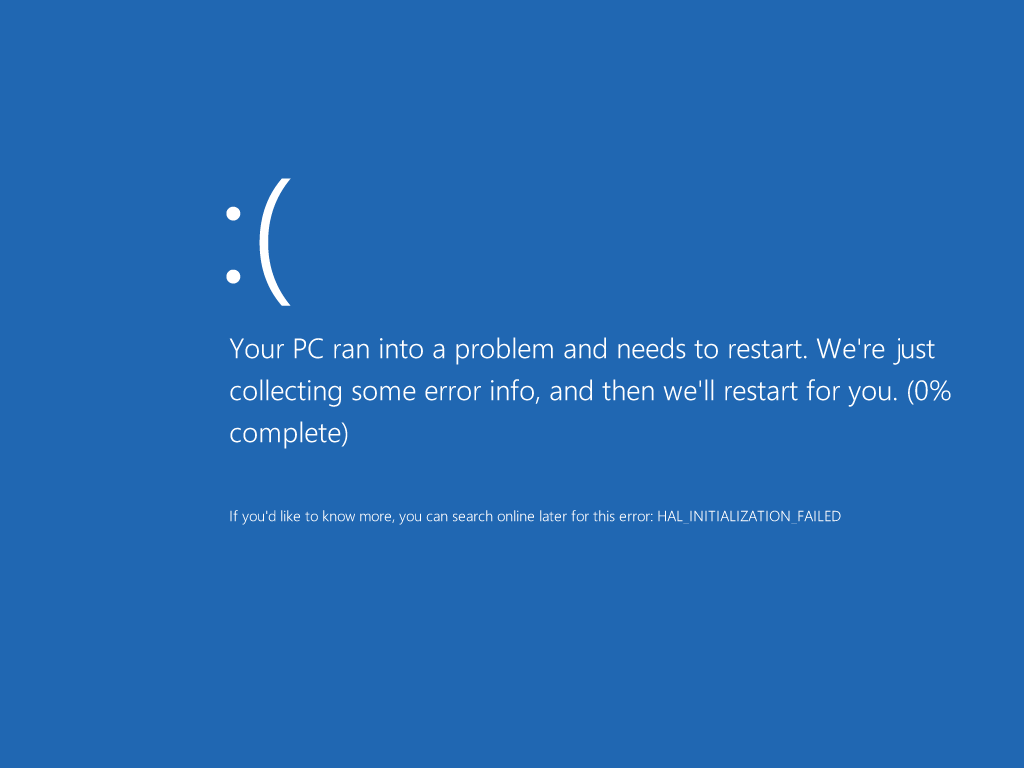| Cerchiamo di localizzare il nostro sito internet in quante più lingue possibili, tuttavia questa pagina è attualmente tradotta automaticamente utilizzando Google Translate. | chiudi |
-
-
prodotti
-
risorse
-
supporto
-
compagnia
-
Una guida al “volume di avvio Unmountable” schermata blu di errore di morteA Guide to the “Unmountable Boot Volume” Blue Screen of Death Error
Da Steve Horton Giugno 20, 2013Blue Screen of Death, bsod, unmountable_boot_volume2 CommentsNome errore: UNMOUNTABLE_BOOT_VOLUME
Codice STOP: 0x000000ED
Sei arrivato qui perché stai vivendo un brutto film Blue Screen of Death: Unmountable Boot Volume. Questo errore non è irrisolvibile o altro, ma sarà un serio problema per te. La schermata di errore che hai dovrebbe apparire come una di queste:

Sulle versioni di Windows precedenti a Windows 8.
Che cosa assomiglia a Windows 8.Prima di tutto, dovrai provare una riparazione all’avvio di Windows. Per tentare la riparazione all’avvio di Windows, è necessario accendere il dispositivo. Tutte le versioni di Windows solitamente la tentano automaticamente, lasciandola sola mentre ci prova. Se Windows non è in grado di gestirlo automaticamente – o BSoD prima che accada o salti direttamente al tentativo di avvio – dovrai prendere una misura più diretta e avrai bisogno di un’unità ottica.
Ogni volta che il tuo computer si avvia, premi MAIUSC + F7 (a volte questa è un’altra combinazione di tasti, che potresti aver bisogno di Google, a seconda del produttore). Questa combinazione di tasti ti farà avviare nel BIOS della tua macchina e da lì puoi modificare l’ordine di avvio in modo che il tuo computer tenti il sistema operativo nell’unità disco anziché nel disco rigido. Utilizzare il disco inizialmente utilizzato per installare Windows per questa fase: inserire il disco nel vassoio del disco, quindi riavviare il computer.
Quando viene visualizzata la schermata di installazione, selezionare l’opzione Ripristina, aprire il prompt dei comandi e digitare chkdsk / r C :. Windows tenterà quindi di riparare il tuo disco rigido. Se ciò non funziona, prova fixboot C: nel prompt dei comandi, ma se il tuo computer non riesce ancora ad avviarsi dal tuo disco rigido, o hai un disco rigido difettoso, c’è un problema nel tuo cablaggio o nel disco rigido solo non è il problema.
L’altro possibile problema è la RAM difettosa: per controllare questo, aprire il computer e rimuovere tutti i bastoni RAM tranne uno. Quindi, prova ad avviare da ciascuno finché non incontri quello che causa il problema.
Se non sei sicuro su come procedere, chiama un tecnico o il tuo produttore. Una volta che tutti questi passaggi sono stati seguiti, si dovrebbe avere una macchina funzionale o capire quale pezzo di hardware nel computer ha causato tutti questi problemi.
Was this post helpful?YesNoGratis Aggiornamenti dei driver
Aggiorna i tuoi driver in meno di 2 minuti per divertirti al meglio Prestazioni del computer - Gratis.
Gratis Aggiornamenti dei driver
Aggiorna i tuoi driver in meno di 2 minuti per divertirti al meglio
Prestazioni del computer - Gratis.
Non hai trovato la tua risposta?Posta una domanda alla nostra community di esperti provenienti da tutto il mondo e ricevere una risposta in pochissimo tempo.più rilevanti articoli recenti Appuntalo su Pinterest